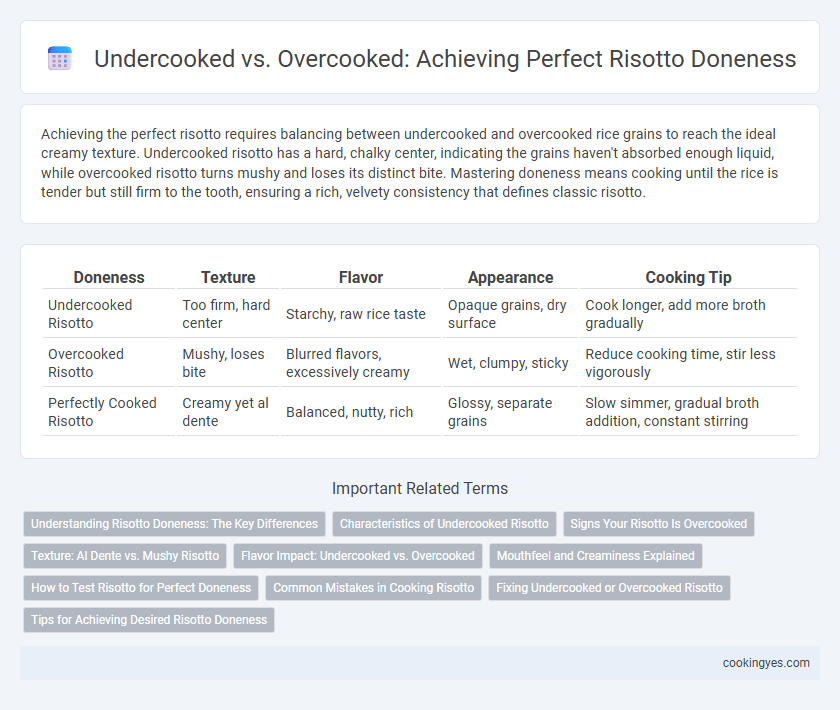Achieving the perfect risotto requires balancing between undercooked and overcooked rice grains to reach the ideal creamy texture. Undercooked risotto has a hard, chalky center, indicating the grains haven't absorbed enough liquid, while overcooked risotto turns mushy and loses its distinct bite. Mastering doneness means cooking until the rice is tender but still firm to the tooth, ensuring a rich, velvety consistency that defines classic risotto.
Table of Comparison
| Doneness | Texture | Flavor | Appearance | Cooking Tip |
|---|---|---|---|---|
| Undercooked Risotto | Too firm, hard center | Starchy, raw rice taste | Opaque grains, dry surface | Cook longer, add more broth gradually |
| Overcooked Risotto | Mushy, loses bite | Blurred flavors, excessively creamy | Wet, clumpy, sticky | Reduce cooking time, stir less vigorously |
| Perfectly Cooked Risotto | Creamy yet al dente | Balanced, nutty, rich | Glossy, separate grains | Slow simmer, gradual broth addition, constant stirring |
Understanding Risotto Doneness: The Key Differences
Risotto doneness hinges on achieving a creamy texture with tender, yet slightly firm Arborio or Carnaroli rice grains that retain a gentle bite. Undercooked risotto presents with hard, chalky centers lacking creaminess, while overcooked risotto becomes mushy and loses the characteristic al dente firmness. Mastering the balance of gradual liquid absorption and gentle stirring ensures perfect consistency and optimal flavor release in each grain.
Characteristics of Undercooked Risotto
Undercooked risotto has a firm, almost crunchy texture with rice grains retaining too much bite, lacking the creamy consistency typical of perfectly cooked risotto. The starch has not fully released, resulting in a drier, less cohesive dish without the smooth, velvety coating. Flavor absorption is limited in undercooked risotto, causing the dish to taste bland and less integrated.
Signs Your Risotto Is Overcooked
Risotto is overcooked when the grains become mushy and lose their distinct, slightly firm texture. The dish may appear overly soupy or clumpy instead of creamy and cohesive. Signs of overcooked risotto also include a dull appearance and a heavy, sticky consistency that lacks the desired al dente bite.
Texture: Al Dente vs. Mushy Risotto
Achieving the perfect risotto texture requires precise timing, where al dente rice offers a firm, slightly chewy bite that retains each grain's individuality. Undercooked risotto feels too hard and grainy, lacking the creamy consistency essential to its signature mouthfeel. Overcooked risotto turns mushy and overly soft, losing structural integrity and resulting in a gluey, unpleasant texture.
Flavor Impact: Undercooked vs. Overcooked
Undercooked risotto features a firm, slightly crunchy texture that highlights the distinct grain structure, resulting in a nutty, less integrated flavor profile. Overcooked risotto becomes mushy and loses individual grain definition, leading to a starchy, overly creamy taste that can mask delicate seasoning nuances. Achieving the perfect al dente doneness ensures balanced chewiness with a rich, harmonious flavor that enhances the overall dining experience.
Mouthfeel and Creaminess Explained
Undercooked risotto has a firm, slightly crunchy texture due to the al dente rice grains, resulting in less creaminess and a more granular mouthfeel. Overcooked risotto becomes overly soft and mushy, losing the signature bite and leading to a watery, less structured creaminess. Achieving desired doneness balances al dente rice with creamy starch release, creating a smooth, velvety texture and rich mouthfeel.
How to Test Risotto for Perfect Doneness
Testing risotto for perfect doneness requires tasting the grains to ensure they are tender but still slightly firm to the bite, known as al dente. Undercooked risotto will be hard and chalky in the center, while overcooked risotto becomes mushy and loses its creamy texture. Using a spoon to sample the rice periodically during cooking helps achieve the ideal balance of creaminess and bite for authentic Italian risotto.
Common Mistakes in Cooking Risotto
Undercooked risotto often results in hard, crunchy rice grains lacking the creamy texture characteristic of properly cooked risotto, caused by insufficient absorption of broth. Overcooked risotto turns mushy and sticky, losing the desirable al dente bite due to excessive cooking and liquid absorption. Ensuring the rice is cooked just until tender but still firm to the bite requires constant stirring and gradual addition of warm broth to avoid these common mistakes.
Fixing Undercooked or Overcooked Risotto
Undercooked risotto can be salvaged by gradually adding more hot broth and gently cooking while stirring until the rice grains become tender but still slightly firm to the bite. Overcooked risotto, which often results in a mushy texture, can be improved by folding in freshly cooked rice or a splash of cream to restore some firmness and richness. Properly balancing liquid absorption and cooking time is essential to achieving the ideal al dente consistency characteristic of classic risotto dishes.
Tips for Achieving Desired Risotto Doneness
To achieve the perfect risotto doneness, ensure the rice grains are tender but still slightly firm to the bite, known as al dente, avoiding undercooked hardness or overcooked mushiness. Stir regularly while gradually adding warm broth, allowing the rice to absorb liquid evenly and release its creamy starch. Taste frequently during cooking to adjust heat and liquid, ensuring ideal texture and rich flavor balance.
Undercooked vs overcooked for desired doneness Infographic

 cookingyes.com
cookingyes.com